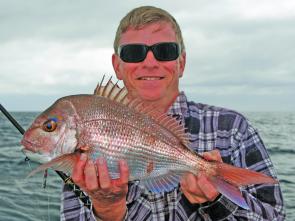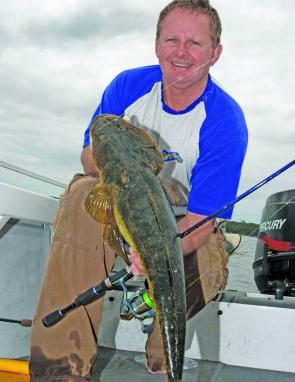Not long now before things start to really hot up, but before they do we should get that nasty little temperature inversion that happens about this time every year.
The hot water in the East Australian Current starts to come down the coast hard, pushing in front of it cold water, even at depth, forcing that cold stuff to the surface and hard onto the coast.
So we get water down to as low as 15° before it all is taken over by the warm tropical water and all the goodies associated with it, so don’t be surprised if the water is 22° degrees one day and 16° the next.
This does have an adverse effect on the fishing, with a hot bite one day going completely flat and all signs of life disappearing the next.
This can be good if you get lucky and find one of those isolated pockets of warm water in a bay or inlet, and when you do you often find everything has crammed into it and is ready to bite.
If the water turns suddenly cold it pays to look around to try to find one of these little warm patches. But for the most part, if the water turns cold go home and wait for it to warm up.
It generally only lasts a couple of days and then all the cold is pushed down the coast or turned back over and the hot fishing is here until May or June.
Yellowfin tuna love to sit on these temperature breaks and at this time of year they can be jumbos. These days, because we don’t target them the first indication that one or two are about is that one of the local snapper fishos gets spooled rapidly when something grabs an unweighted pilchard.
If you hear of this get out there fast and hope they are still about or move down the coast to, say, the Sir John Young Banks off Currarong and hope they pull in there for a bit.
More consistent are the kings over the inshore reefs. The usual places like Bellambi Bommie, the islands and Bass Point all hold fish but can get crowded.
If you get out early and have big live slimy mackerel or squid you will get your fair share.
As always some days are better than others with good fish up to 10kg common. A big popper ripped back past the livies will often get things going and hook the ones that only belt your baits and not eat them. Some big, educated fish can do this so hang on tight to that popper outfit.
Bonito will become a problem when using bigger live baits. They can slash your hard-earned baits to bits. Casting metal slugs will get the bonnies and save your live bait supply.
Most of the snapper are to 2kg and are holding over the gravel in about 40m although a few are around the shallower reefs and bommies.
If the current allows, anchoring over the edges of gravel and reef will work, as will drifting with big plastics, although the leatherjackets can give the plastics a hiding.
If there is current, try feeding an unweighted bait out about 50m to 80m and then attach a sinker to the line and drop it over.
This will sink down, bringing your bait through the water column and cover all depths from top to bottom. Quite often when the reds are up in the berley trail the bait will be taken before you attach the sinker.
Make up sinkers of varying weights prior to your trip by attaching a small length of line and a snap swivel, then just clip on when needed and remove before feeding out the next bait.
Over the reefs there are also some nice mowies, pigfish and small samson, and you might even pick up a few teraglin leading up to the full moon.
Over the sand there are heaps of good flathead on all the recognised flattie drifts and minimal leatherjackets, so all is looking good.
There are more pelagics arriving every day with the baitfish. Striped tuna are from the backs of the beaches to well offshore and bonito, tailor and salmon are carving up the baitfish – just look for diving birds and the splashes, particularly in the northern regions.
Cast small shiny metals into the schools and retrieve at pace. You can troll but this generally puts the fish down and off the bite.
Further offshore there are a few yellowfin about on the shelf but most boats are starting to target striped marlin from 60 fathoms and out. Stripes don’t mind whacking lures but it will soon be time to start trolling live baits because the black marlin will not be too far away. Let’s hope it is an early season; they have been late in the past few years.
Mahi mahi should start to gather around the FADs as the water settles down to a consistently warm temperature.
Drummer are still in the rocky washes taking royal red prawns or cabbage and some nice blackfish are holding in the harbours early in the mornings but you will need good weed, berley and patience.
Good spots include the breakwalls inside and outside Port Kembla, in Wollongong Harbour under the little light and just inside Kiama Harbour.
The main focus will be on salmon and bonito on the deeper ledges of Kiama, Bombo, Bass Point, Port Kembla and Coalcliff and off the breakwalls. Lures and floating pilchards are getting them, as are flies under bobby corks
There are some nice bream in the washes and quiet bays with green prawns as good as any bait, if you can stand the pickers.
On the subject of prawns, Lake Illawarra has an excellent run of great numbers but is down, although they should get bigger as the season progresses.
With the prawn run come the flatties, bream and whiting. The flathead are all over the place taking live prawns, poddies and plastics.
Don’t forget the Deans Bait and tackle, Wollongong Sportfishing Club annual flathead comp is on again on 15th January. I’m looking to defend my title and better the 6.8m total length of flatties I caught last year, so come on and have a crack at the great prizes on offer.
Whiting are down around the entrance and on the flats before the drop-off, with bream all along the weed beds and rocky shores and around the islands. A few well-placed live prawns in the creek snags should turn up some big fish.
The entrance to the lake has a few jewies and heaps of salmon and tailor.
It’s the same on the beaches with some solid jewies around. Good numbers of schoolies up to 6kg are about but be prepared for fish of over 20kg.
Salmon again are thick and can be a nuisance grabbing jewie baits but they are fun on light tackle, as are some of the big tailor just on dark. Fish to 3kg and are on most beaches.
Whiting will be the fish of choice during the daylight hours but live beach worms are a must for good results.
Reads: 3032
If you work it right, there are some jewies about munching soft plastics..

The gravel is where you will find tasty little snapper at the moment.

Flatties are all the go in the estuaries this month. Work the deeper drop-offs near weed beds in the lake.




